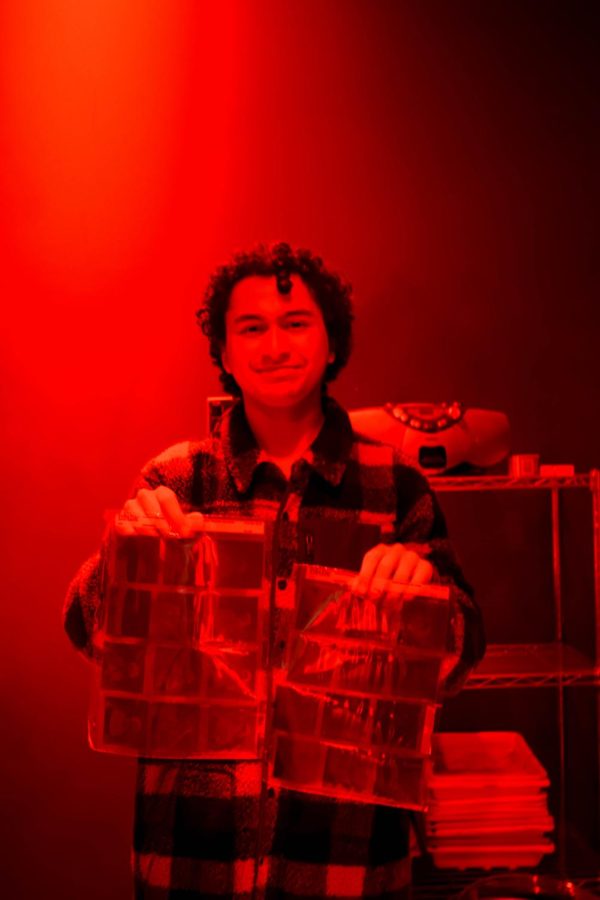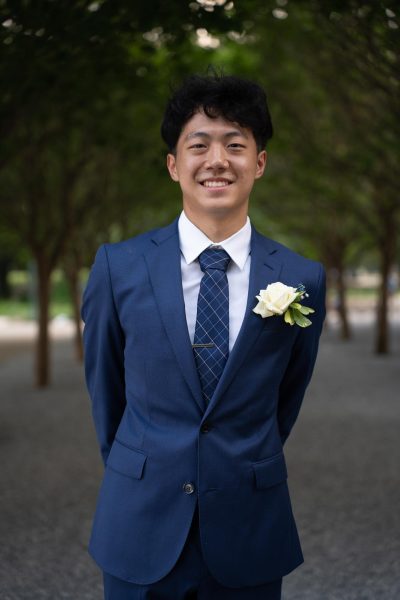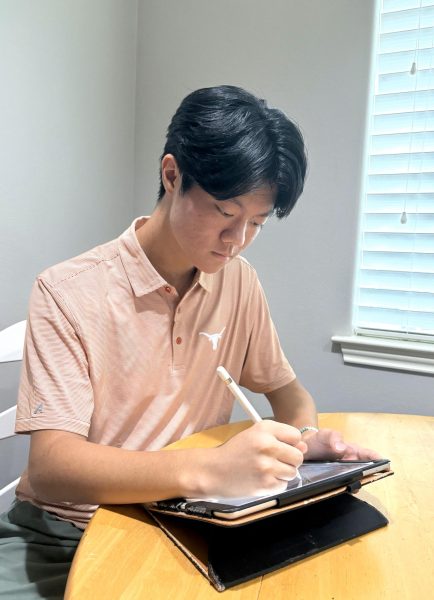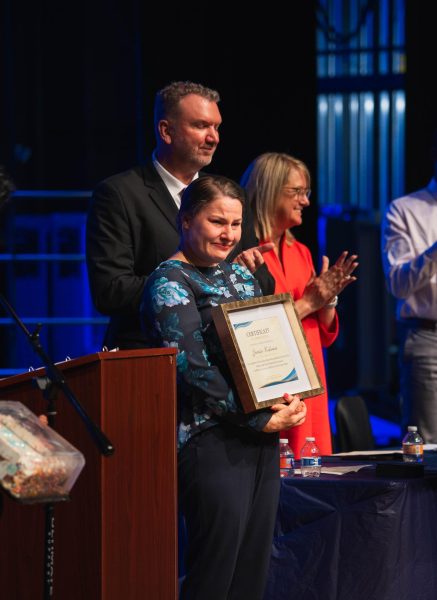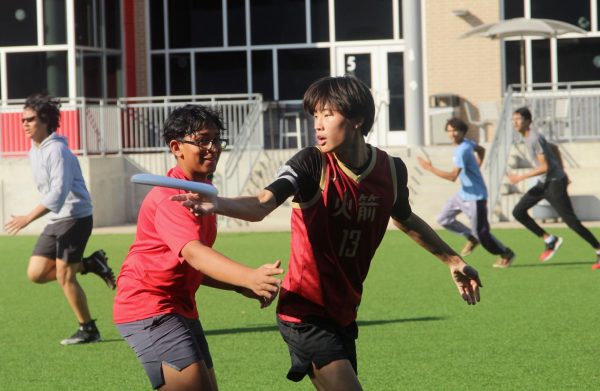Under the red lights: Bellaire’s new darkroom
AP photography student Exequiel Fleitas, 12, is holding film he processed in the darkroom. Students are learning about negative and positive while developing film.
As the only photography teacher–teaching everything from Photo 2 to AP Photography– Kelly Quarles has revived Bellaire’s photography program by rebuilding the darkroom.
When people think of darkrooms, they may think of the creepy red rooms in horror movies, but Bellaire’s isn’t used like the ones in movies.
In the room, photographers make prints from their negatives (inverted photographs) in red lights to protect their light-sensitive film papers to use for larger projects and practice. It’s nothing like a serial killer’s planning room.
The red lights are used to protect black and white people from light because they don’t process in white lights.
“Ideally what will be happening in there is you have a series of chemicals that you run [the negative] through to have the image develop and fix and become a nice final print,” Quarles said.
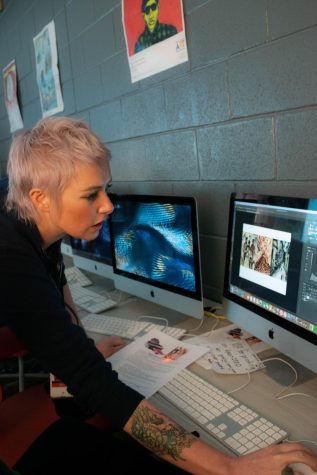
Coming from Cypress Ridge High School and Cypress Ranch High School with a more darkroom and filmed focused photography program, Quarles knows how experiencing the magical process of the darkroom makes students fall in love with photography.
To truly understand Quarles’ passion for the darkroom, people need to know why she started teaching photography.
Quarles always knew she wanted to become a teacher but it wasn’t until she took an AP Photography class in high school that she figured out teaching photography would be the path she wanted to explore.
“I signed up for photography my sophomore year in high school,” Quarles said. “I was always interested in different kinds of arts, but I heard photography was really fun and the teachers are really cool and they did a lot of awesome stuff.”
Her curious interest in photography developed into a 13-year career–seven at Bellaire–in which she grew to love introducing the world of photography to students.
“I like teaching,” Quarles said. “I like working with my hands to make [project demos] and I like socializing.”
Quarles teaches a total of three photography classes. In photo 2, students learn the foundation of photography and the camera while working on projects independently to build skill. Photo 3 teaches more techniques and is an AP portfolio building year. In AP photography students pick their own theme for the year and explore it through multiple mediums for college portfolio building.
Although adding a darkroom to the new photography room was Quarles’ idea, she gives all the credit to former principal Michael McDonough for pushing to make sure it came out as planned.
“Whenever I was interviewing at Bellaire, I saw that Bellaire was getting a rebuild, so I asked how likely it would be for a small darkroom to be built into [the new building],” Quarles said. “Mr. McDonough believed in my vision, responding, ‘well, you’re just so passionate about it how could I tell you no?’”
This moment would lead to the rebirth of Bellaire’s darkroom.
“Throughout the process of the new building being built, he got me into multiple meetings with the architects,” Quarles said. “It was really really special because I do not think any other principal I have worked for would have gotten me into those meetings to make [a darkroom] happen for our students.”
In those meetings, Quarles ensured she was specific in what she needed to make a darkroom work.
“I made proposals and designed everything that needed to go in there,” Quarles said. “I let them know there’s special ventilation and silver recovery drainage in the scene.”
These ventilations and drainages are required for the chemicals and dirty water to go through after processing is completed.
During the building process, Quarles expressed why she pushed so hard for the darkroom to be built.
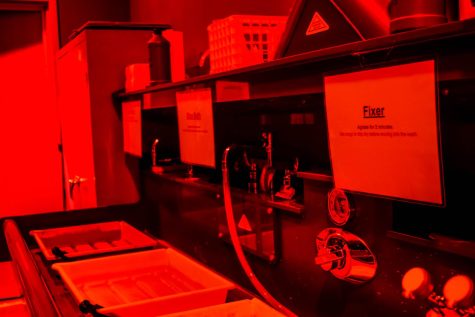
“I think it’s really special,” Quarles said. “It’s just a whole different experience. You get to see where [films] came from. You will have a deeper understanding and appreciation for the people who came before us and where these processes come from.”
Working in the darkroom not only helps with the film but also helps photographers understand digital programs such as Photoshop.
“You’re going to have a deeper understanding even in Photoshop,” Quarles said. “If you understand how to dodge and burn then you understand that it all came from the darkroom. So much technology or terminology came from the darkroom.”
For senior and AP Photography student Odalis Santacruz, Quarles’ love for guiding students into photography is felt when she steps through the classroom’s door.
“Mrs. Quarles is energetic and passionate about teaching photography,” Santacruz said. “She’s always so joyful to be there and helping us out with new ideas to create.”
Despite it being her third year in photography class, Santacruz says working in the darkroom has expanded her interest in photography.
“Working in the darkroom has actually increased my interest in photography,” Santacruz said. “Whenever I’m there working, it makes me feel like I’m working professionally. It gives us the ability to get a better experience on the job. I enjoy being able to work with chemicals to develop black and white film.”
If you are interested in learning more about the darkroom and photography, talk to Mrs.Quarles in room 2304.
Your donation will support the student journalists of Bellaire High School. Your contribution will allow us to purchase equipment and cover our annual website hosting costs.


